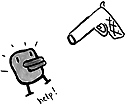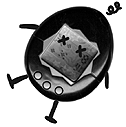

 |
|

Can a cute little virtual pet slow
the ticking of the proverbial biological clock? We put our single career
girl to the virtual mommy test.
by Hillari Dowdle
The damn Tamagotchi's not dead yet. It's a beautiful, sunny October day,
and I've sneaked home from work early to revel in the demise of my inane
virtual pet—to ceremoniously bury it deep in the kitchen garbage can,
then throw a revelatory, celebratory wake. But no, there it is, happily waddling
back and forth on the palm-sized screen, oblivious to my overt attempts to
cut short its virtual life.
Of course, it's not waddling far, owing to the steaming heaps of Tamagotchi
excrement I've allowed to collect on the screen and the large skull symbol
hovering menacingly overhead. Were I a caring virtual parent, I'd see that
as a sign that the little fellow is sick and in desperate need of medicine.
But I'm not.
A cursory glance at the Tamagotchi's health-o-meter lets me know that it's
nearly starving to death and deeply unhappy—as it should be, since I've
purposely not fed it, cleaned it, played with it, or even let it sleep for
a good 48 hours now. Still, the damn thing won't expire.
I've tried everything, too, mind you. Cramming food down the critter's virtual
gullet continuously until it expanded from 5 to 99 pounds in a five-minute
period, turning the lights off in the middle of the day and on in the still
of the night, shocking it repeatedly and for no good reason with the gizmo's
"discipline" function—seemingly none of these heinous acts diminished
the varmint's virtual joie de vivre. I've screamed at it, insulted
it, and done everything in my power to erode its self-esteem and will to
virtually live, all for naught. Letting my actual pet, a hyperactive adolescent
tomcat, have a go at it did no good either. All that batting, gnawing, clawing,
hissing, screeching, and slobbering, and then...nada.
And now that malevolent neglect seems to be failing, I simply don't know
what to do, where to turn. I realize I could crush the thing like a bug,
smash it until its microprocessors were reduced to so much housedust, but
that would be cheating. And though I'm a virtual homicidal maniac right now,
I do have my ethics. No, I'll just have to wait patiently for the thing to
give up, for the elixir of starvation, toxic environment, psychic abuse,
and play deprivation I've concocted to cast its lethal spell.
Stick a Fork in Mork...He's
Done
It's the irony that's killing me. For I didn't start out this way, bucking
to commit a virtual felony like voluntary Tamagotchicide. I had nothing but
the best intentions, plans to provide for the little cyber creature to the
best of my ability.
A pop culture aficionado, I'd been interested in Tamagotchis from the moment
the little Japanese imports hit our shores back in May. These virtual
pets—or "lovable eggs" as their name directly translates—had taken
the Japanese youth market by storm, so the hype had it, the hottest thing
since Ultraman. Like so many others of the post-Space Invaders generation,
I'm instantly fascinated by video-game technology, and so was more than mildly
curious. Plus, I love pets—the more the merrier. And the idea of reaping
all the love and affection without the veterinarian bills, Science Diet expense,
and compounded litterbox output was appealing.
Still, I probably wouldn't have invested my $14.95 at Toys 'R' Us had not
my clever Metro Pulse editors seen the potential humor in having an
over-30 single career gal with no prospects of marriage or desire for family
life (despite the wheedling pleas of her near-desperate mother) appease
the assumed urgings of her biological clock by writing a tongue-in-cheek
account of her experiences as a "virtual mommy." Ha.
Assignment accepted, I underwent a blissful virtual pregnancy, one in which
my cheeks glowed as I ran from store to store in search of a genuine,
Bandai-produced Tamagotchi, my complexion radiant under the fluorescent lights.
True to its reputation as the Tickle Me Elmo of 1997, the Tamagotchi proved
elusive—though every toy, video, department, grocery, and discount store
in Knoxville offers an array of knock-offs, from Dinkie Dinos to Giga Pets
to something called Hitorikku. I would have to keep checking back, stock
clerks informed me—Tamagotchi shipments fly off the shelves.
But the persistence (motivated by a looming deadline, it's true) paid off,
and two weeks later I found my virtual holy grail and bought one. The birthing
process itself was an easy one—it involved simply pulling out a paper
tab from the side of the contraption to awaken the Tamagotchi from its
"million-light-year sleep"—and labor was limited to 30 minutes or so
of plowing through four pages of instructions on the feeding and care of
the new addition to the family. By the time my Tamagotchi—which I lovingly
dubbed Mork—hatched, I was ready.
There are three buttons on the Tamagotchi, and that's enough to meet all
its virtual needs, which include nourishment, play, medicine, discipline,
hygiene, and sleep. In addition to these functions, the toy has a health
meter that displays its age, weight, and degrees of discipline, health, and
happiness. The idea is to keep it happy and healthy. It's a high-tech version
of the sack of flour all 13-year-old girls used to be required by sadistic
home-ec teachers to lug around junior high in order to get just a taste of
the responsibilities of parenthood, only without the attendant mess that
develops as "babies" spring leaks.
Like all newborns, Tamagotchis are needy, requiring constant care and feeding
during the first months (which, in human time, translates into hours) of
their life. There's no breastfeeding, just selection of a meal or snack icon;
no dirty diapers, just a sweeping of mounds of Tamagotchi doo off the screen;
no pediatrician bills, just the highlighting of the "medicine" icon to give
baby Tam a shot; and no crying, just an intermittent beeping to indicate
its disgruntlement with its current state of affairs.
Born on a Saturday, little Mork had my undivided attention. I was there to
feed him constantly, to clean his screen, to make sure all the attendant
childhood illnesses were treated, and to play with him. Tamagotchis need
lots of play, I quickly learned, as their happiness meter is wont to quickly
deplete. Unfortunately, little Tam knows only one game, and it's a boring
one: It shows you a number, and you guess whether the next will be higher
or lower, a process you repeat five times to the accompaniment of an annoying
electronic "song."
I took Mork everywhere—to restaurants, to the gym, to the grocery store,
out for a walk, to the mall. And come Monday morning, I even took him to
work, where he proceeded to interrupt an important client meeting no less
than three times with its whiny beeping. Fortunately, my peers assumed the
Tam was a beeper, and I was leaving to return an urgent phone message rather
than indulge the spoiled-rotten baby with the umpteenth round of high/low.
By day four, the novelty was wearing thin. The game was becoming repetitive
and to my mind, unrewarding. After all, the mechanism itself is a simplistic
one, relying solely on the laws of cause and effect. You feed it, its hunger
meter fills up; you play with it, its happiness meter fills up. There's no
emotion and no attachment, and though I tried bragging to my friends and
co-workers about little Mork's lovable personality and high IQ, they remained
unimpressed.
Then I discovered a trick. I could avoid the stupid little game altogether
by feeding Mork "snacks" in order to artificially pump up its happiness meter.
This was fast, efficient, and much quieter, and I was more than willing to
communicate to my baby that junk food is equivalent to happiness, despite
the risk of setting into motion life-long destructive eating patterns that
would no doubt end in obesity or eating disorders.
Little did I know that my constant coddling with snack food was undermining
little Mork's health. He became fat—his weight soaring to 99 pounds
within a few hours—and sickly. And then, on day seven, he returned to
his home planet, leaving me bereft.
Fortunately, new Tamagotchis can be hatched ad infinitum, and after
an appropriate three-minute mourning period, I hatched another one. This
one, Spock, grew into a different character than Mork (there are six different
characters), and lived to the ripe old age of 9. Then there was Warf, who
lived to be 6, and then Alf, who despite my best efforts succumbed to sudden
infant virtual death syndrome (SIVDS) by age 3.
Numb from my losses, I stopped caring, tossing my Tamagotchi into my glove
compartment to be forgotten along with the Alpha-Bits license plate, Lava
Lick candy, and a pack of Nat Sherman Fantasia lights left over from a wild
night of partying months before. I was ready to move on.
But then my editors started calling. They needed that story, they explained.
And if I had given up on motherhood, too bad. I'd just have to refresh my
memory. And so, I did.
Beam Me Up, Virtual
Scotty
At last, my Tamagotchi's in its death throes. I can tell by the insistent
beeping growing slower and slower by the moment. The little fellow is flattened
against the bottom of the screen, his eyes reduced to two flat slashes.
It's interesting to note that whereas the original Tamagotchis in Japan
officially did die, as indicated by the appearance of a spirit on
the display screen, their American cousins do not. Rather, they return to
their home planet in a far-out little space ship. Apparently, Tamagotchis
will always "return home" eventually, whether you take good care of them
or not, where we're ostensibly to assume that they live out the rest of their
virtual days in peace and harmony.
I wonder what Bandai executives were thinking when they decided that the
American market couldn't handle exposure to so heart-wrenching a prospect
as virtual demise. Perhaps they figured that what with Oliver Stone on the
job, we don't need anymore virtual death. Or perhaps they harbor romantic
notions—fueled by such cultural pap as Norman Rockwell prints, Little
House on the Prairie reruns, and Coke commercials—and about the
sanctity of American childhood. Or perhaps they just didn't want to give
rise to the next psychopathic serial killer (they always start out killing
pets, you know, virtual or otherwise).
Whatever the case, I'm not falling for their ruse. I'm 32 years old now,
old enough to know the truth: that Tamagotchi is DEAD. Fini. The end.
Which is not to say that I didn't learn anything from my experience. Indeed,
I learned that we are given to anthropomorphize not just plants and animals,
but cyber creatures as well—other Tamagotchi mommies I chatted with
(and the 12,000-some-odd parents posting their experience on AOL's Tamagotchi
message boards) tended to assign their babies emotions like happy or sad
or angry or content, when really they're just LED dots dancing to a predetermined
string of code. I learned that happiness can't be found in a plastic-encased
2-D environment. And I learned that I should probably be postponing parenthood
as a personal option indefinitely. Sorry, Mom.

|